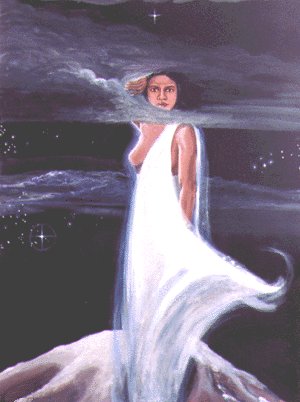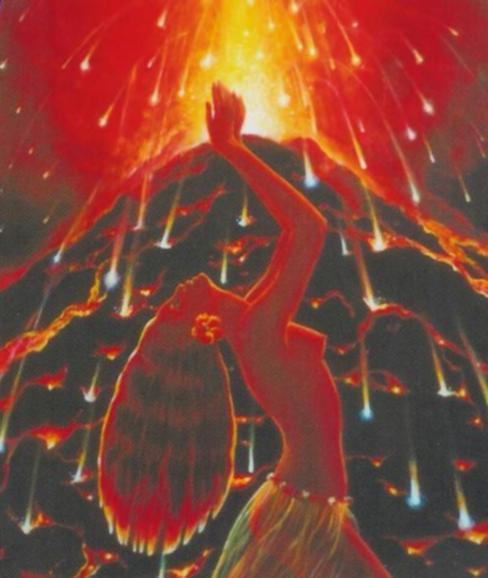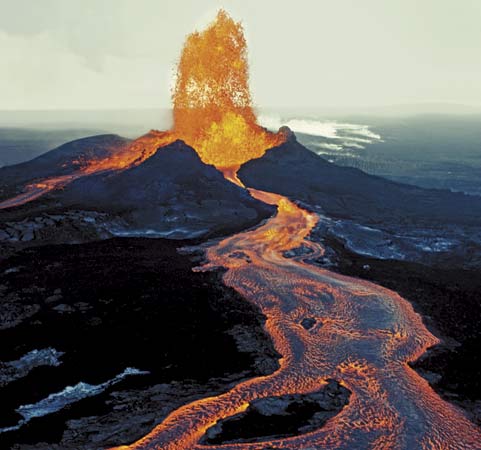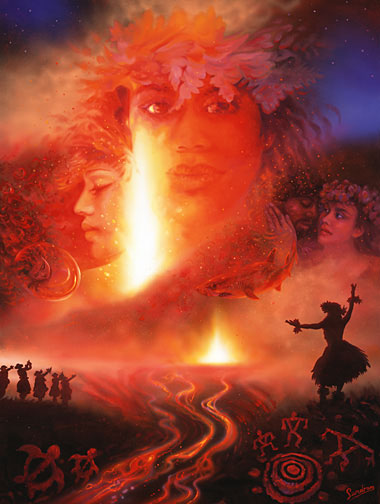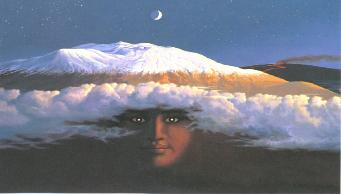The Feminine Divine
SHAKTI
The Goddess
Shakti
is power, energy in both its dynamic and static forms (we know its static form better as "matter."). Every imaginable thing and action in the universe arises from, exists in, and eventually returns to the primordial shakti pool. Absolute, unchangeable, permanent, all-pervasive consciousness is the rock upon which the universe stands, and our cosmos and all conceivable cosmoses assemble themselves on that rock from the substance and dynamism of shakti, defined as feminine in essence.
- Dr. Robert Svoboda
- Dr. Robert Svoboda
Simhamukha - The secret form of Guru Rinpoche.
Arising from the state of the Dharmadhatu, the Mother of all conquerors, Queen of all the countless Dakini's; With magic powers smashing to dust hindrances and enemies.
I pay homage to Simhamukha; The Lion Faced Dakini
Arising from the state of the Dharmadhatu, the Mother of all conquerors, Queen of all the countless Dakini's; With magic powers smashing to dust hindrances and enemies.
I pay homage to Simhamukha; The Lion Faced Dakini
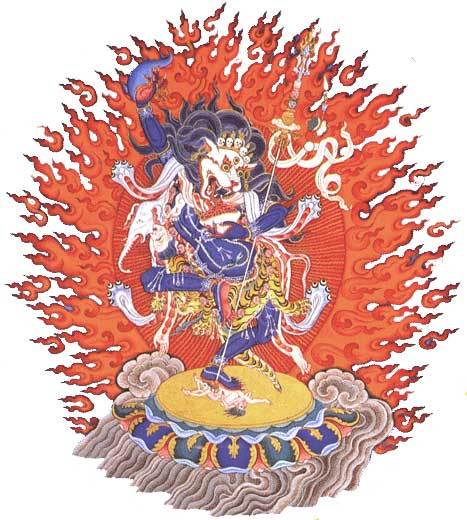
Tara The Buddha Mother
"There are many who wish to gain enlightenment in a man's form, and there are few who wish to work for the welfare of sentient beings in a female form.
Therefore may I, in a female body, work for the welfare of beings right until samsara has been emptied."
Tara- The Liberator
The Lion Faced Dakini-Simhamuhka


Kali
"Whatever Her unfathomable purpose, it seems now to please Kali to materialize Herself in the West. Yet to be resolved is how well Her hosts here will realize Whom it is that has descended upon them as their guest. It is easy in the modern world to mistake the external image for its internal substance, particularly when that image is exotic and power-laden, for devis (goddesses) do not appear in the average Westerner's lexicon.
A Calcutta woman once told a Canadian visitor, "Devi is the Sanskrit root of your English word divine , and you still use it today for the closest thing to goddesses your culture can bear to recognize - divas."
What you obtain in life will depend in great measure on what kind of shakti you invite into it. Kali takes Her mission to kill and transform [ego] seriously, as should everyone who approaches Her. Come to Her with humility, and She will infuse you with new vitality when you need it most. Come to Her flippantly, and if you are very lucky She will ignore your insolence instead of reprimanding you. Scheme to manipulate Her power and She will give you a good long karmic rope with which to hang
yourself." -Dr. Robert Svoboda
(Homage to Vimalanada ji)
In Vajrayana Buddhism, the three aspects of refuge are taken as the Lama-the teacher, Yidam-the protector, and the Khandro- the Dakini; the activity manifestation of the Buddhas. The Dakini has her roots in the ancient sources of Buddhist history but has appeared in many forms, in many cultures, under many names throughout time. In this section we explore a few of the different faces and forms of the Goddess and the primal forces for which she represents.
Dakini
- Sky Dancer
Dakinis have been explained as "emanations of Enlightened Mind". To possess "enlightened mind" is another way of saying, "holding the bodhisattva commitment." It can connote the wish for enlightenment not for one's self alone, but for the benefit of all sentient beings. Dakinis' are female Bodhisattva's.
In the Buddhist tradition there are several types of female beings who are described as dakinis. These female beings can range in temperament and appearance ranging from terrifying and grotesque, in order to challenge the practitioner's conceptual mind - to liberated and divine displaying the beauty, skill and sophistication of the Goddess lineage. According to tradition it is nearly impossible to recognize a dakini in any of her forms. It is due to this that the mystery surrounding the Dakini lore has prevaded Buddhist texts and biographies throughout its history.
Although dakini figures appear in Hinduism and in the Bön tradition, dakinis (Sky Dancer's) are particularly prevalent in Vajrayana Buddhism and have been particularly conceived in Tibetan Buddhism where the dakini, generally of volatile or wrathful temperament, act somewhat as a muse (or inspirational thoughtform) for spiritual practice. Dakinis are energetic beings in female form, evocative of the movement of energy in space. In this context, the sky or space indicates shunyata, the insubstantiality of all phenomena, which is, at the same time, the pure potentiality for all possible manifestations.
Dakinis, being associated with energy in all its functions, are linked with the revelation of the Anuttara Yoga Tantras or Higher Tantras, which represent the path of transformation. Here, the energy of negative emotions or kleshas, called poisons, are transformed into the luminous energy of enlightened awareness or (jnana) yielding to the pure Mind (rigpa).
Dakinis have been explained as "emanations of Enlightened Mind". To possess "enlightened mind" is another way of saying, "holding the bodhisattva commitment." It can connote the wish for enlightenment not for one's self alone, but for the benefit of all sentient beings. Dakinis' are female Bodhisattva's.
In the Buddhist tradition there are several types of female beings who are described as dakinis. These female beings can range in temperament and appearance ranging from terrifying and grotesque, in order to challenge the practitioner's conceptual mind - to liberated and divine displaying the beauty, skill and sophistication of the Goddess lineage. According to tradition it is nearly impossible to recognize a dakini in any of her forms. It is due to this that the mystery surrounding the Dakini lore has prevaded Buddhist texts and biographies throughout its history.
Although dakini figures appear in Hinduism and in the Bön tradition, dakinis (Sky Dancer's) are particularly prevalent in Vajrayana Buddhism and have been particularly conceived in Tibetan Buddhism where the dakini, generally of volatile or wrathful temperament, act somewhat as a muse (or inspirational thoughtform) for spiritual practice. Dakinis are energetic beings in female form, evocative of the movement of energy in space. In this context, the sky or space indicates shunyata, the insubstantiality of all phenomena, which is, at the same time, the pure potentiality for all possible manifestations.
Dakinis, being associated with energy in all its functions, are linked with the revelation of the Anuttara Yoga Tantras or Higher Tantras, which represent the path of transformation. Here, the energy of negative emotions or kleshas, called poisons, are transformed into the luminous energy of enlightened awareness or (jnana) yielding to the pure Mind (rigpa).
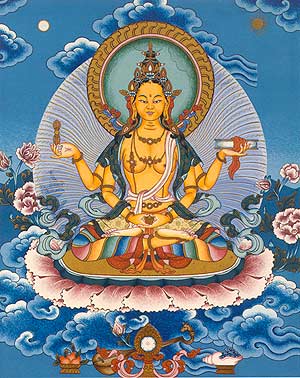
Prajnaparamita Tibetan: Yumchenmo- Great Mother. The name means "the perfection of wisdom", the wisdom of all buddhas personified in the enlightened form of a female deity
The Prajnaparamita-Sutra is regarded as the holy mother that feeds the bodhisattva with the amrita (nectar) of prajna (transcendental wisdom), and guides him to paramita (the other shore).


Tara is known as The Faithful One, The Fierce Protectress, an archetype
of inner wisdom. Tara speaks of a transformation of consciousness, a
journey to freedom. She teaches simple and direct means for each
person to discover within themselves the wisdom, compassion and glory
that is Tara.
She is the feminine counterpart of the bodhisattva - Avalokitesvara (Tibetan: Chenrezig). According to Buddhist history, she came into existence from the tear of Avalokitesvara, which fell to the ground when he saw the tremendous suffering of sentient beings. Out of the tear formed a lake, and through its waters rose up a lotus, which, on opening, revealed the goddess Tara. Like Avalokitesvara, she is a compassionate deity who helps souls 'cross to the other shore', to liberation. She is the protectress of navigation and earthly travel, as well as of spiritual travel along the path to Enlightenment.
White Tara is one of her many manifestations symbolizing longevity and purity. She is adorned with representations of the Tri-kaya (three vehicles) and Four Immeasurables with wisdom eyes on her hands and feet including a third eye on her forehead blazing in primordial bliss. She emerges as all the Buddhas and Bodhisattvas in essence and acts on behalf of all.
She is the feminine counterpart of the bodhisattva - Avalokitesvara (Tibetan: Chenrezig). According to Buddhist history, she came into existence from the tear of Avalokitesvara, which fell to the ground when he saw the tremendous suffering of sentient beings. Out of the tear formed a lake, and through its waters rose up a lotus, which, on opening, revealed the goddess Tara. Like Avalokitesvara, she is a compassionate deity who helps souls 'cross to the other shore', to liberation. She is the protectress of navigation and earthly travel, as well as of spiritual travel along the path to Enlightenment.
White Tara is one of her many manifestations symbolizing longevity and purity. She is adorned with representations of the Tri-kaya (three vehicles) and Four Immeasurables with wisdom eyes on her hands and feet including a third eye on her forehead blazing in primordial bliss. She emerges as all the Buddhas and Bodhisattvas in essence and acts on behalf of all.

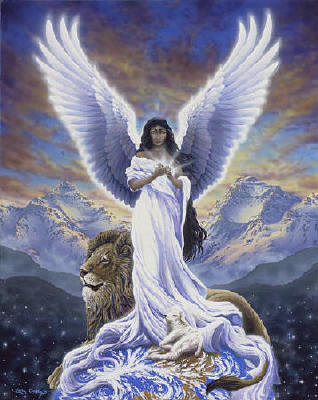
Kali: The Dark Mother
Fearful goddess with a heart of a mother
By, Subhamoy DasThe love between the Divine Mother and her human children is a unique relationship. Kali, the Dark Mother is one such deity with whom devotees have a very loving and intimate bond, in spite of her fearful appearance. In this relationship, the worshipper becomes a child and Kali assumes the form of the ever-caring mother.
"O Mother, even a dullard becomes a poet who meditates upon thee raimented with space, three-eyed, creatrix of the three worlds, whose waist is beautiful with a girdle made of numbers of dead men's arms..." (From a Karpuradistotra hymn, translated from Sanskrit by Sir John Woodroffe)
Who is Kali?
Kali is the fearful and ferocious form of the mother goddess. She assumed the form of a powerful goddess and became popular with the composition of the Devi Mahatmya, a text of the 5th - 6th century AD. Here she is depicted as having born from the brow of Goddess Durga during one of her battles with the evil forces. As the legend goes, in the battle, Kali was so much involved in the killing spree that she got carried away and began destroying everything in sight. To stop her, Lord Shiva threw himself under her feet. Shocked at this sight, Kali stuck out her tongue in astonishment, and put an end to her homicidal rampage. Hence the common image of Kali shows her in her mêlée mood, standing with one foot on Shiva's chest, with her enormous tongue stuck out.The Fearful Symmetry
Kali is represented with perhaps the fiercest features amongst all the world's deities. She has four arms, with a sword in one hand and the head of a demon in another. The other two hands bless her worshippers, and say, "fear not"! She has two dead heads for her earrings, a string of skulls as necklace, and a girdle made of human hands as her clothing. Her tongue protrudes from her mouth, her eyes are red, and her face and breasts are sullied with blood. She stands with one foot on the thigh, and another on the chest of her husband, Shiva.Awesome Symbols!
Kali's fierce form is strewed with awesome symbols. Her black complexion symbolizes her all-embracing and transcendental nature. Says the Mahanirvana Tantra: "Just as all colors disappear in black, so all names and forms disappear in her". Her nudity is primeval, fundamental, and transparent like Nature — the earth, sea, and sky. Kali is free from the illusory covering, for she is beyond the all maya or "false consciousness." Kali's garland of fifty human heads that stands for the fifty letters in the Sanskrit alphabet, symbolizes infinite knowledge.Her girdle of severed human hands signifies work and liberation from the cycle of karma. Her white teeth show her inner purity, and her red lolling tongue indicates her omnivorous nature — "her indiscriminate enjoyment of all the world's 'flavors'." Her sword is the destroyer of false consciousness and the eight bonds that bind us.
Her three eyes represent past, present, and future, — the three modes of time — an attribute that lies in the very name Kali ('Kala' in Sanskrit means time). The eminent translator of Tantrik texts, Sir John Woodroffe in Garland of Letters, writes, "Kali is so called because She devours Kala (Time) and then resumes Her own dark formlessness."
Kali's proximity to cremation grounds where the five elements or "Pancha Mahabhuta" come together, and all worldly attachments are absolved, again point to the cycle of birth and death. The reclined Shiva lying prostrate under the feet of Kali suggests that without the power of Kali (Shakti), Shiva is inert.
Forms, Temples and Devotees
Kali's guises and names are diverse. Shyama, Adya Ma, Tara Ma and Dakshina Kalika, Chamundi are popular forms. Then there is Bhadra Kali, who is gentle, Shyamashana Kali, who lives only in the cremation ground, and so on. The most notable Kali temples are in Eastern India — Dakshineshwar and Kalighat in Kolkata (Calcutta) and Kamakhya in Assam, a seat of tantrik practices. Ramakrishna Paramhamsa, Swami Vivekananda, Vamakhyapa, and Ramprasad are some of the legendary devotees of Kali. One thing was common to these saints — all of them loved the goddess as intimately as they loved their own mother."My child, you need not know much in order to please Me.
Only Love Me dearly.
Speak to me, as you would talk to your mother,
if she had taken you in her arms."
The Mother Goddess & Her Symbolism
[Excerpts] From Shri Gyan RajhansGoddess Durga is the mother of the universe and believed to be the power behind the work of creation, preservation, and destruction of the world. Since time immemorial she has been worshipped as the supreme power of the Supreme Being and has been mentioned in many scriptures - Yajur Veda, Vajasaneyi Samhita and Taittareya Brahman.
The Meaning of "Durga"
The word "Durga" in Sanskrit means a fort, or a place which is difficult to overrun. Another meaning of "Durga" is "Durgatinashini," which literally translates into "the one who eliminates sufferings." Thus, Hindus believe that goddess Durga protects her devotees from the evils of the world and at the same time removes their miseries.The Many Forms of Durga
There are many incarnations of Durga: Kali, Bhagvati, Bhavani, Ambika, Lalita, Gauri, Kandalini, Java, Rajeswari, et al. Durga incarnated as the united power of all divine beings, who offered her the required physical attributes and weapons to kill the demon "Mahishasur". Her nine appellations are Skondamata, Kusumanda, Shailaputri, Kaalratri, Brahmacharini, Maha Gauri, Katyayani, Chandraghanta and Siddhidatri.Durga's Many Arms
Durga is depicted as having eight or ten hands. These represent eight quadrants or ten directions in Hinduism. This suggests that she protects the devotees from all directions.Durga's Three Eyes
Like Shiva, Mother Durga is also referred to as "Triyambake" meaning the three eyed Goddess. The left eye represents desire (the moon), the right eye represents action (the sun), and the central eye knowledge (fire).Durga's Vehicle - the Lion
The lion represents power, will and determination. Mother Durga riding the lion symbolises her mastery over all these qualities. This suggests to the devotee that one has to possess all these qualities to get over the demon of ego.Durga's Many Weapons
- The conch shell in Durga's hand symbolizes the 'Pranava' or the mystic word 'Om', which indicates her holding on to God in the form of sound.
- The bow and arrows represent energy. By holding both the bow and arrows in one hand "Mother Durga" is indicating her control over both aspects of energy - potential and kinetic.
- The thunderbolt signifies firmness. The devotee of Durga must be firm like thunderbolt in one's convictions. Like the thunderbolt that can break anything against which it strikes, without being affected itself, the devotee needs to attack a challenge without losing his confidence.
- The lotus in Durga's hand is not in fully bloomed, It symbolizing certainty of success but not finality. The lotus in Sanskrit is called "pankaja" which means born of mud. Thus, lotus stands for the continuous evolution of the spiritual quality of devotees amidst the worldly mud of lust and greed.
- The "Sudarshan-Chakra" or beautiful discus, which spins around the index finger of the Goddess, while not touching it, signifies that the entire world is subservient to the will of Durga and is at her command. She uses this unfailing weapon to destroy evil and produce an environment conducive to the growth of righteousness.
- The sword that Durga holds in one of her hands symbolizes knowledge, which has the sharpness of a sword. Knowledge which is free from all doubts, is symbolized by the shine of the sword.
- Durga's trident or "trishul" is a symbol of three qualities - Satwa (inactivity), Rajas (activity) and Tamas (non-activity) - and she is remover of all the three types of miseries - physical, mental and spiritual.
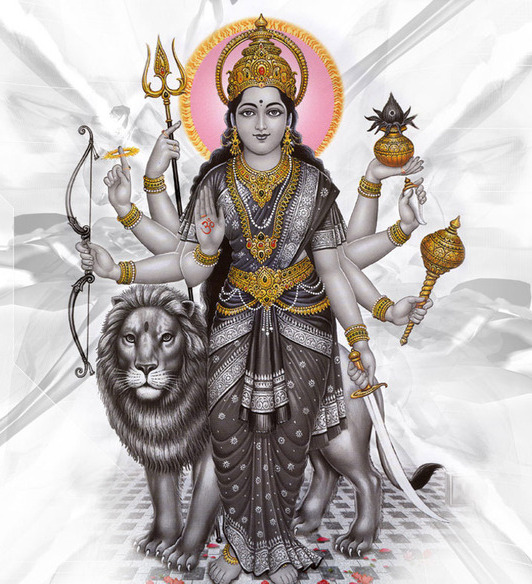

Simhamukha or Senge Dongma can be translated into English as Lion-Faced Dakini. This dakini and female tantric Buddha is regarded as one of the principal fierce manifestations of Padmasambhava, the 8th Century mahasiddha who was a founder of the Nyingma or 'Ancient School' of Tibetan Buddhism. As such, she is connected with many ceremonies of the Dzogchen tradition. A fierce dakini, she is also one of the Phramenma, a group of female deities from the Bardo Thödol, or 'Tibetan Book of the Dead'. When fully appreciating the benefits of this wrathful wisdom deity (according to the Nyingma tradition), she is the principal Dakini teacher of Padmasambhava. Simhamukha is iconographically represented as a wrathful deity who is usually depicted as a dark blue, or maroon, coloured lion-faced female and is associated with the direction East. As Simhavaktra, an alternate form of Simhamukha, she is also an attendant of the Dharmapala Palden Lhamo, in which case she is depicted as carrying both a kapala (skullcup), and a kartika (ritual knife)
Every Hindu temple has the face of lion at the apex entrance carved artistically. This lion-face appears at the top of the door, niche, and windows as well. The countenances of man and lion are fused and it is also known as Simhamuka or Simhalalata. It is supposed to lead worshippers to Supreme Reality.
The dakini Simhamukha is a tutelary deity arising out of the Chakrasamvara cycle of Tantras and belongs to the Anuttarayoga 'wisdom' classification..
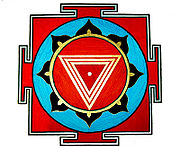
DURGA
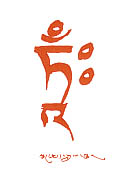

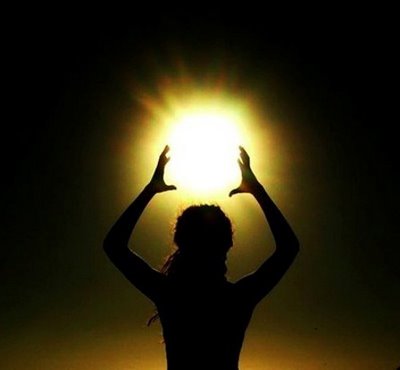

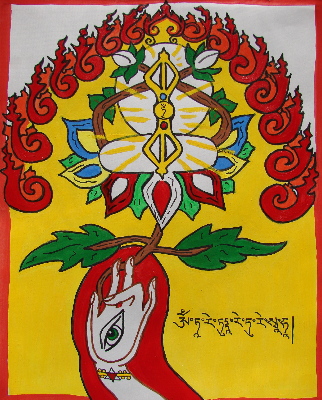
Goddess Pele
Her poetic name, Ka wahine `ai honua, the woman who devours the land, is both creator and destroyer. She throws molten fountains into the air, governs the great flows of lava, and has been known to reveal herself throughout the island of Hawaii. Pele is a goddess of fire, lightning, dance, volcanoes and violence.
Pele, the Hawaiian goddess of the volcano, was born in Honua-Mea, part of Tahiti. She was one of a family of six daughters and seven sons born to Haumea (a very ancient Earth goddess) and Kane Milohai (creator of the sky, earth and upper heavens).
There are a number of variations in the legends that tell of how Pele first came to the Hawaiian Islands. One of the most common relates that she was exiled by her father because of her temper, most recently for fighting with her elder water-goddess sister Na-maka-o-Kaha'i, whose husband Pele had seduced.
Pele is often depicted as a wanderer, constantly traveling her domain. Sightings of Pele have been reported all over the islands of Hawaii for hundreds of years, but especially near craters and her home, Mount Kilauea, one of the most active volcanoes on Earth.
Pele is known for her violent temper, but also for her common visits among mortals. She is said to appear either as a tall, beautiful young woman or as a very old, ugly and frail woman. She is often accompanied by a white dog and typically tests people. Myths are told of Pele wandering up to people in the form of an old beggar woman, asking them if they have any food or drink to spare. Those who share with her are rewarded and spared. Those who are greedy and unkind to her are punished by having their homes or crops destroyed, so that they themselves may have to rely on the kindness of others.
According to Hawaiian historian David Malo in his book "Hawaiian Antiquities," in old Hawai'i, some gods and goddesses, including Pele, were believed to be akua noho, gods who talked. They could take possession of an earthly being, who became the god's kahu.
***
The musician Tori Amos named an album Boys for Pele in her honor. A single lyrical excerpt from the song "Muhammad My Friend" makes the only outright connection, "You've never seen fire until you've seen Pele blow." However, the entire record deals with the ideas usually associated with Pele, such as feminine "fire," or power. Amos claims the title reflects the idea of boys being devoured by Pele, or alternately, as boys worshipping Pele.
Sources of Information Include: Answers.com
Her poetic name, Ka wahine `ai honua, the woman who devours the land, is both creator and destroyer. She throws molten fountains into the air, governs the great flows of lava, and has been known to reveal herself throughout the island of Hawaii. Pele is a goddess of fire, lightning, dance, volcanoes and violence.
Pele, the Hawaiian goddess of the volcano, was born in Honua-Mea, part of Tahiti. She was one of a family of six daughters and seven sons born to Haumea (a very ancient Earth goddess) and Kane Milohai (creator of the sky, earth and upper heavens).
There are a number of variations in the legends that tell of how Pele first came to the Hawaiian Islands. One of the most common relates that she was exiled by her father because of her temper, most recently for fighting with her elder water-goddess sister Na-maka-o-Kaha'i, whose husband Pele had seduced.
Pele is often depicted as a wanderer, constantly traveling her domain. Sightings of Pele have been reported all over the islands of Hawaii for hundreds of years, but especially near craters and her home, Mount Kilauea, one of the most active volcanoes on Earth.
Pele is known for her violent temper, but also for her common visits among mortals. She is said to appear either as a tall, beautiful young woman or as a very old, ugly and frail woman. She is often accompanied by a white dog and typically tests people. Myths are told of Pele wandering up to people in the form of an old beggar woman, asking them if they have any food or drink to spare. Those who share with her are rewarded and spared. Those who are greedy and unkind to her are punished by having their homes or crops destroyed, so that they themselves may have to rely on the kindness of others.
According to Hawaiian historian David Malo in his book "Hawaiian Antiquities," in old Hawai'i, some gods and goddesses, including Pele, were believed to be akua noho, gods who talked. They could take possession of an earthly being, who became the god's kahu.
***
The musician Tori Amos named an album Boys for Pele in her honor. A single lyrical excerpt from the song "Muhammad My Friend" makes the only outright connection, "You've never seen fire until you've seen Pele blow." However, the entire record deals with the ideas usually associated with Pele, such as feminine "fire," or power. Amos claims the title reflects the idea of boys being devoured by Pele, or alternately, as boys worshipping Pele.
Sources of Information Include: Answers.com
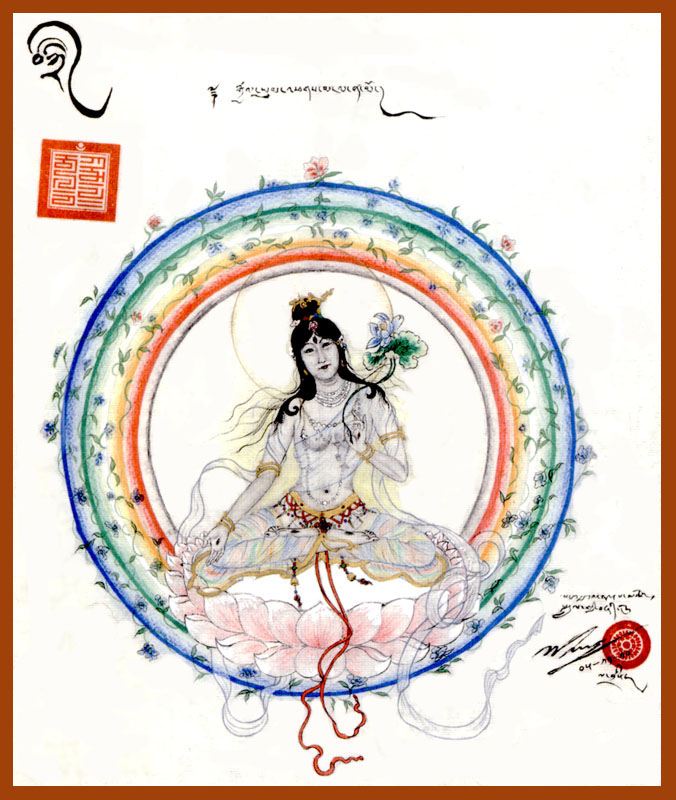
Painting by HH Gyalwa Karmapa
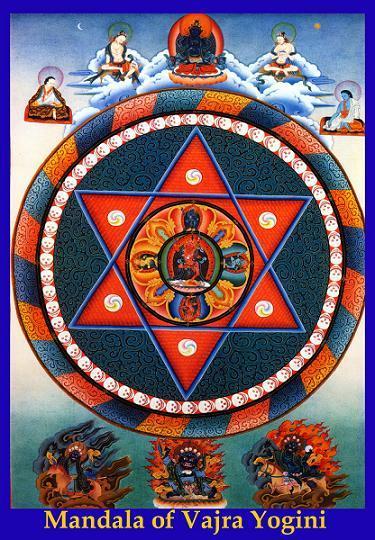
The title of Vajrayogini
translates as 'the diamond female yogi'. She is a Highest
Yoga Tantra Yidam, and according to Je Tsongkhapa her practice includes methods
for preventing ordinary death, intermediate state and rebirth, and for
transforming all daily experiences into spiritual paths.
Vajrayogini is a female yidam, dakini and a Vajrayana Buddhist meditation deity. As such she is considered to be a female Buddha.
In her form as Vajravarahi, when she is known as 'the Vajra Sow' she is often pictured with a sow's head on the side of her own and in one form has the head of a sow herself. Vajrayogini is often associated with triumph over ignorance, the pig being associated with ignorance in Buddhism.
According to Miranda Shaw, Vajrayogini is: "inarguably the supreme deity of the Tantric pantheon. No male Buddha, including her divine consort, Heruka-Cakrasamvara, approaches her in metaphysical or practical import.
Vajrayogini is a female yidam, dakini and a Vajrayana Buddhist meditation deity. As such she is considered to be a female Buddha.
In her form as Vajravarahi, when she is known as 'the Vajra Sow' she is often pictured with a sow's head on the side of her own and in one form has the head of a sow herself. Vajrayogini is often associated with triumph over ignorance, the pig being associated with ignorance in Buddhism.
According to Miranda Shaw, Vajrayogini is: "inarguably the supreme deity of the Tantric pantheon. No male Buddha, including her divine consort, Heruka-Cakrasamvara, approaches her in metaphysical or practical import.
Vajrayogini
From Kyabje Bokar Rinpoches book "Tara The Feminine Divine"
"The perfection of emptiness has no form, it is emptiness of the Absolute Body (Dharmakaya). This emptiness however, has the capability to manifest itself purely as the Body of Enjoyment (Sambhogakaya). It is on the level of the Body of Enjoyment that feminine deities such as Tara, Vajravarahi (Dorje Palmo), and many others appear. All of them in essence are the perfection of knowledge or the nature itself of our mind.
It is also said that Tara is the "Mother of all Buddhas", which refers also to her essence. The nature of mind, perfection of knowledge and emptiness are, in fact, equivalent terms. All past Buddhas have attained buddhahood by realizing emptiness (or realizing the nature of mind). It is the same for present buddhas and it will be the same for future buddhas. Thus, Tara- the Tara beyond time, space and all concepts- is the Mother of all Buddhas.
According to stories of the pedagogical truth, known through the work of Tananatha, a 16th century lama of great realization and scholarship, Tara was a woman before becoming a diety.
***
Her story began incalculable ages ago in a world called, "Multicolor Light", where the Drum Sound Buddha dwelled. One of the king's daughters at this time, called Wisdom Moon, possessed great faith and devotion to this buddha. For many years, she made immense offerings to this Buddha and his entourage of monks.
One day, she decided to take the Bodhisattva vow in the presence of the Buddha Drum Sound, that is, to promise to attain awakening to benefit beings in infinite ways. The monks rejoiced greatly at her decision, and considering that she would accumulate great merit by this activity, advised her to pray in order to obtain in a future life the body of a man as this would allow her to benefit beings and the dharma better than in a female existence.
Wisdom Moon, distressed by the monks narrowness of mind, answered them from the point of view of the ultimate nature of things: "Here, no man, no woman. No "I", no individual, no categories. "Man" or "Woman" are only denominations created by confusion or perverse minds in this world. She added that there were many who followed the path in a mans body, few in a womans body. "As for myself", she said, "as long as samsara is not emptied I will benefit beings appearing in a female body." Such was her promise. Her practice then allowed her to realize ultimate truth. Having become a goddess, she has placed millions of beings on the path of awakening each day.
Later, during the kalpa Without Beginning, there lived a monk called Stainless who received the empowerment of compassion of all the buddhas' mind. He became the deity Avalokiteshvara (Chenrezig). The five victors, the Buddhas who reign over the five families of awakening, gave him a special empowerment. This caused Tara to arise from his heart, coming through this mode of manifestation to accomplish the buddhas' wishes and work at benefiting beings during that kalpa. (In some versions, Tara appears from Avalokitshvara's tear drop.) For this reason, Tara also has the name "Daughter of the Worlds' Soverreign, " that is, daughter of Avalokiteshvara.
Tara, the Swift and Courageous Daughter of the Worlds' Soverreign, has been benefiting beings during many kalpas by manifesting in various ways and accomplishing various activities through particular states of concentration.
Such is Taras story in the domain of manifestation.
The prayer of The Four Immeasurables is the expression of Tara's wisdom and compassion in union....
The Four Immeasurables
May all beings have happiness and the causes of happiness
May they be free from suffering and the causes of suffering
May they never be apart from the sacred happiness which is free of suffering
May they dwell in the great equanimity, free of attachment and aversion.

Poliahu- Hawaiian Snow Goddess
In Hawaiian mythology, there are stories told of the four snow goddesses who ruled over the mountains north of Kilauea. They wore elegant cloaks of snow in the high summits, which they traded for garments of golden sunshine from time to time. They were goddesses of nature who clothed mountain peaks in snow, which would melt into life giving streams as the maidens came down from the heights and made their way to the sea.
Lilinoe, Waiau, Kahoupokane and Poliahu were their names, but the most detailed stories are of Poliahu. She was resplendent with beauty and charm. She was quick of wit, gracious in manner, and adventurous in spirit.
Poliahu loved to frequent the cliffs that towered above the Hamakua coast. Sometimes she would join the games and sports that the mortal chiefs engaged in. More often, she would simply rest and watch the waves crash against the cliffs in great white sprays of foam.
It was on one such occasion, that the Chief Aiwohikupua of Kauai was passing through the area and saw the beautiful Poliahu. She beckoned to him to approach, and so enchanted was he, that he proposed marriage at that first meeting. Poliahu promised to marry the handsome chief and they exchanged cloaks in honor of their upcoming union.
Chief Aiwohikupua went to Kauai and assembled a host of canoes which he filled with singers and musicians, close friends and family. He donned the white cloak and a grand helmet of red feathers, and returned to Hawaii.
Poliahu, accompanied by the other snow maidens, went to greet Aiwohikupua when his party landed on the beach. As the women approached, the visitors from Kauai shivered with cold and looked at one another uneasily. So the maidens wrapped themselves in golden sunshine and spread warmth to the people. The following days were spent in the joyous celebration of the marriage festival. Poliahu then went with Aiwohikupua back to Kauai where celebrations began anew.
It was in the midst of these celebrations that a queen of Maui arrived. She confronted the couple, revealing that Aiwohikupua had promised marriage to her. The chief could not deny it. Poliahu was angered and abandoned her husband to his previous engagement.
Aiwohikupua and the Maui chiefess reconciled with the help of the chief ' s close friends, and arrangements were made for their marriage ceremony. When the special day arrived, the chiefess was plagued with a terrible chill that settled deep in her bones. In despair, she ran to the chief for help. Aiwohikupua told her that Poliahu had wrapped a snow mantle around her and instructed her to go to the fire to warm herself. The chiefess did so, and when she got to the fire, the cold dissipated. Her relief was short lived as she was overcome with an unbearable raging heat. The chief declared that it was the anger of Poliahu. Frightened, the Maui chiefess left Aiwohikupua and fled back to her homeland.
Then, the cold descended on the chief and his friends. The frozen grip upon them was powerful and unforgiving. They shivered in blankets and cloaks, huddled together at the fires, but could do nothing for it as death approached. Then, Poliahu and the snow maidens appeared before the chief in ethereal and terrible beauty, their snow cloaks sparkling so brightly in the sun that they were hard to look upon. One more frosty breath, they cast upon the chief and his friends, before forsaking Kauai forever.
Source: www.nativehawaii.com/legends/snow_godds.php
